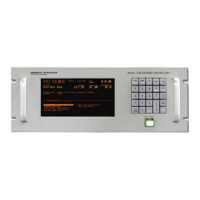Overview
2.0 OVERVIEW OF THE 7200 ACS
2.1 General Information About the 7200 ACS
The 7200 ACS is an antenna pointing system, controlled manually or
automatically, that positions the antenna to receive the peak signal from one or
more communications satellites. The 7200 ACS uses microprocessor technology to
provide accurate antenna positioning, high reliability, and maximum system
flexibility. The system has the capabilities for rapid multiple satellite access, highly
sophisticated predictive tracking with inclined orbit satellites, and EIA/TIA-232E,
EIA/TIA-422B, IEEE-488 (Optional) remote control communications, and 10BASE-T
Ethernet.
In two-axis applications, azimuth (AZ) and elevation (EL) controls are used to
position the antenna. The three-axis applications use AZ, EL, and polarization (POL)
controls to position the antenna and feed assembly. The four-axis applications use
AZ, EL, and two polarizations (POL & 4TH AXIS) to control the position of the
antenna and feed assembly. Variable speed inverters provide two-speed operation
for AZ and EL with continuously variable drive rates over a range of approximately
50 to 1. The 7150 Drive Cabinet houses the drive controls and interfacing
equipment to the 7200 ACS. The 7150 Drive Cabinet is normally mounted on the
antenna foundation.
A large 8-inch by 4-inch electro-luminescent display and a sensible, uncluttered
keypad form a user interface which is fully menu-driven and includes context-
sensitive help messages. With much detail paid to the man-machine interface, the
7200 ACU provides straightforward access to an extremely versatile ACS.
The 7200 offers a number of operational modes including manual jog control,
several programmed positioning modes, "conventional" steptrack, and the
revolutionary Orbit Prediction Track (OPT) mode. OPT provides tracking
performance approaching that of monopulse control systems by combining efficient
steptrack operation with advanced orbital propagation algorithms to produce a
state-of-the-art, predictive tracking method. With OPT, the 7200 provides highly
accurate tracking with minimal initial data (approximately 1.25 hours for initial
model development).
Two-speed motor control is provided as standard equipment, not through the use
of expensive clutched arrangements or dual-wound drive motors, but with standard
three-phase induction motors, controlled by solid-state variable frequency inverters.
This approach not only provides a reliable and cost-effective means of two-speed
operation (with ratios of up to 50 to 1), but also allows for more precise
positioning than conventional Alternating Current (AC) motor control systems
which simply use contactors to switch motor power on and off. This is a result of
the ability of the inverter to "ramp" the motor speed up or down in a controlled
manner rather than simply removing motor power while at full speed. This can
result in uncontrollable coasting and inevitable "overshoot" of the target.
2-1

